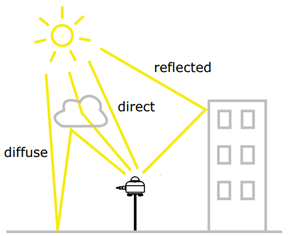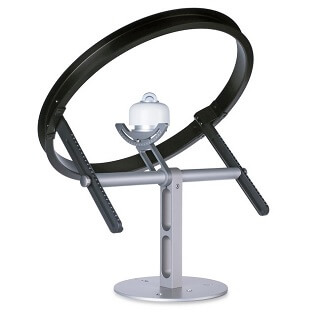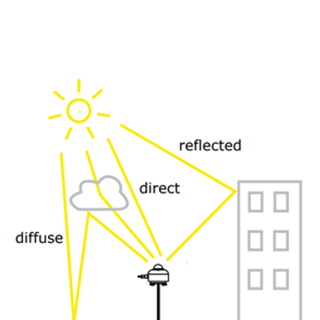Correction factor for using shadowed pyranometers
In 2016 an article was published regarding the use of a shadow-band on pyranometers. The article was published by Elsevier named: ‘Shadow-band radiometer measurement of diffuse solar irradiance; Calculation of geometrical and total correction factors’. The study was conducted by M. de Simón-martín, M. Díez-Mediavilla and C. Alonso-Tristán. The aim of the study was to create a universal correction factor applicable to all different orientations in which pyranometers could be installed, as opposed to already existing correction factors which are only applicable to a specific orientation.

Types of solar irradiance
When a pyranometer is used, it measures the incoming irradiance. This irradiance is defined as the Global Horizontal Irradiance, or ‘GHI’. The GHI consists of two components: the Direct Normal Irradiance (DNI), and the Diffuse Horizontal Irradiance (DHI). The DNI is the irradiance directly coming from the sun and the DHI is the irradiance emitted by surrounding objects and scattered around the atmosphere before reaching the pyranometer. The image depicts the different types of irradiance.
To measure the diffuse irradiance, it is common to use a shading mechanism. This often consists of an ‘eye’ or a band, blocking the direct irradiance from the sun. The residual irradiance measured by the pyranometer is the DHI.

Correcting the Diffuse Horizontal Irradiance
To use this method correctly, a correction should be applied to the measured values of the pyranometer. The correction is needed because the shading band or shading eye also blocks some of the diffuse irradiance from the pyranometer.
The study has created a correction factor, ‘the Generalized Geometrical Correction Method’ or GGCM. This method is applicable to all different orientations in which pyranometers could be installed. Previously used correction factors only applied to specific orientations, like horizontally tilted pyranometers or equator-oriented pyranometers.
One of the characteristics of the newly developed correction factor is that it is derived theoretically instead of empirically. Empirically derived formulas always need a lot of data from similar studies or similar situations. A theoretically derived correction factor has the advantage of being more widely applicable and being more reliable in new measurement setups.
Testing correction method with pyranometers
To test the correction factor that they had developed, they performed irradiance measurements for eight months. For these measurements they used Hukseflux SR11 pyranometers and the Hukseflux DR01 pyrheliometer. All pyranometers were calibrated against a reference pyranometer, the Hukseflux SR21, which was in turn calibrated at the World Radiation Center in Switzerland.
After comparing 4 different correction methods the study concludes that any correction model improves the raw data. The ‘LeBaron Correction Method’ (LBCM), proved to yield the best results. The GGCM also yielded positive results, especially oriented north. The study considers the newly developed correction method a start for a reliable universal correction factor.
Original article: ‘Shadow-band radiometer measurement of diffuse solar irradiance: Calculation of geometrical and total correction factors’.









